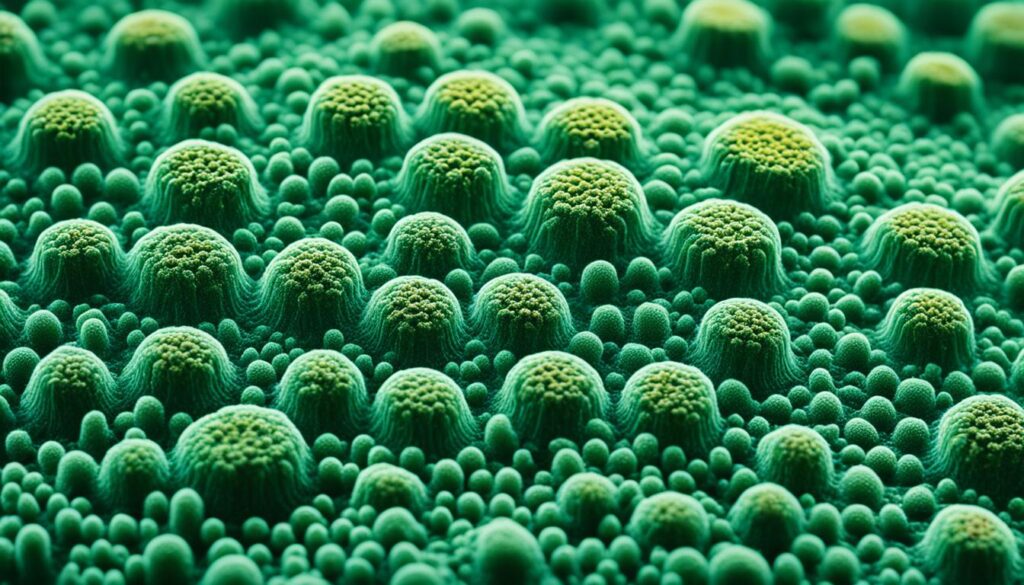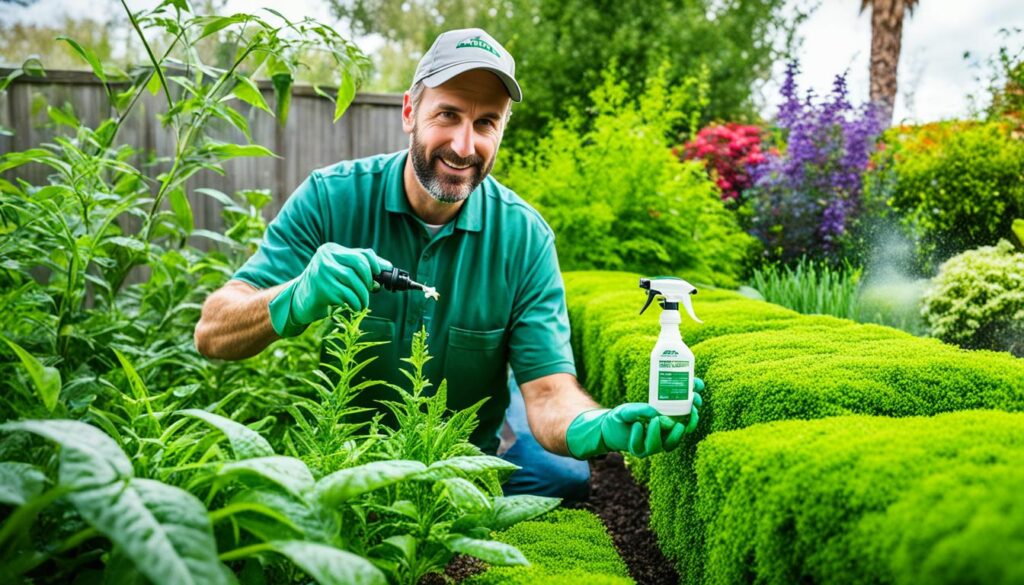
Navigating Through the Challenges of alternaria Mold
Welcome to our informative guide on addressing the challenges associated with alternaria mold and creating a healthier home environment. As a homeowner, ensuring the well-being of your family and maintaining a clean living space is a top priority. Alternaria mold, a common allergen, can pose significant challenges if not properly managed. Let’s explore the impact of alternaria mold on your home and discover effective strategies for combating this issue.
Key Takeaways:
- Alternaria mold can negatively impact the health of your home environment.
- Understanding the characteristics and health risks associated with alternaria mold is crucial.
- Preventive measures can help minimize the presence of alternaria mold in your home.
- Combatting alternaria mold requires a combination of DIY efforts and professional assistance.
- By implementing effective strategies, you can create a healthier living environment for you and your family.
Stay with us as we dive deeper into the world of alternaria mold and equip you with the knowledge and tools to overcome its challenges. Together, we’ll create a healthier, mold-free home environment that promotes well-being.
Understanding Alternaria Mold
Alternaria mold is a common allergen that can pose various health risks, particularly to individuals with allergies or respiratory conditions. In this section, we will delve into the details of alternaria mold, its characteristics, and how it can affect your health. We will also explore preventive measures that can help reduce its presence in your home environment.
Characteristics of Alternaria Mold
Alternaria mold belongs to the genus Alternaria and is a type of filamentous fungi commonly found in indoor and outdoor environments. It thrives in damp conditions, such as areas with high humidity levels or water damage. This mold has a dark green or black color and a velvety texture, making it easily distinguishable.
Health Risks of Alternaria Mold
Exposure to alternaria mold can trigger allergic reactions in susceptible individuals. Common symptoms may include sneezing, coughing, watery eyes, and nasal congestion. Additionally, this mold can worsen respiratory conditions like asthma, leading to difficulty breathing and wheezing. Prolonged exposure to alternaria mold may also increase the risk of developing respiratory infections.
Did You Know? Alternaria mold is one of the most common triggers of mold allergies, and its spores are present in the outdoor air throughout the year.
Preventing Alternaria Mold
Prevention is key to reducing the presence of alternaria mold in your home. Here are some effective preventive measures:
- Keep indoor humidity levels below 50% to create an inhospitable environment for mold growth. Use dehumidifiers if necessary.
- Fix any leaks or water damage promptly to prevent moisture accumulation.
- Ensure proper ventilation in bathrooms, kitchens, and other areas prone to moisture by using exhaust fans or opening windows.
- Clean and dry areas prone to dampness regularly, such as bathrooms, basements, and crawl spaces.
- Inspect and maintain your HVAC system to prevent moisture buildup and mold growth.
By implementing these preventive measures, you can significantly reduce the presence of alternaria mold in your home environment and protect your health.

| Preventive Measures | Benefits |
|---|---|
| Keeping indoor humidity below 50% | Creates an inhospitable environment for mold growth |
| Fixing leaks promptly | Prevents moisture accumulation and mold growth |
| Proper ventilation in moisture-prone areas | Reduces the likelihood of mold growth |
| Regular cleaning and drying of damp areas | Prevents moisture buildup and mold colonization |
| Maintaining HVAC system | Minimizes moisture and mold growth |
Effective Strategies for Combating Alternaria Mold
If you want to ensure a healthier living environment and minimize the presence of alternaria mold in your home, it’s crucial to implement effective strategies for prevention and remediation. By taking proactive measures and seeking professional assistance when necessary, you can effectively combat the growth and spread of this common allergen.
Preventive Measures
Prevention is key when it comes to combating alternaria mold. By addressing the underlying causes and taking proactive steps, you can reduce the risk of mold growth in your home. Here are some preventive measures you can implement:
- Keep humidity levels in check: Maintain humidity levels below 50% to create an environment that is less favorable for mold growth. Use dehumidifiers if needed.
- Fix any leaks: Promptly repair any leaks in your plumbing, roof, or windows to prevent moisture accumulation, which can lead to mold growth.
- Proper ventilation: Ensure proper ventilation in areas prone to moisture, such as bathrooms, kitchens, and laundry rooms. Use exhaust fans and open windows when necessary.
- Regular cleaning: Regularly clean and dry areas prone to moisture, such as shower curtains, bathroom tiles, and windowsills. Pay attention to hidden areas where moisture can accumulate.
Remediation Techniques
If you suspect or detect alternaria mold in your home, it’s crucial to take immediate action to prevent its spread and potential health risks. Here are some remediation techniques you can consider:
- Isolate the affected area: If possible, close off the affected area to prevent the mold spores from spreading to other parts of the house.
- Wear protective gear: When handling mold, wear protective gear such as gloves, goggles, and a mask to minimize your exposure to mold spores.
- Clean and disinfect: Use appropriate cleaning products and techniques to remove mold from surfaces. Ensure thorough drying to prevent future moisture issues.
- Prevent future growth: Identify and address the underlying causes of mold growth, such as leaks or excessive moisture, to prevent future infestations. Consider conducting regular inspections and maintenance.
Importance of Professional Assistance
While preventive measures and remediation techniques can be effective in managing alternaria mold, severe cases may require professional assistance. Professional mold remediation experts have the necessary experience, knowledge, and equipment to handle complex mold issues. They can conduct thorough inspections, provide expert advice, and carry out safe and effective mold removal to restore a healthy living environment for you and your family.
Remember, when it comes to combating alternaria mold, prevention is key, and seeking professional assistance can ensure the best possible outcome. By implementing these strategies, you can create a healthier home environment and minimize the risks associated with mold infestation.

Conclusion
Throughout this article, we have explored the challenges posed by alternaria mold and its impact on the health of your home environment. By understanding the characteristics and health risks associated with alternaria mold, you can take proactive steps to prevent its growth and minimize its presence in your living spaces.
Implementing effective strategies such as maintaining proper ventilation, managing indoor humidity levels, and addressing moisture issues promptly can significantly reduce the risk of alternaria mold infestation. Regular cleaning and thorough inspections also play a crucial role in preventing the proliferation of this common allergen.
In severe cases of mold infestation, it is essential to seek professional assistance. Mold remediation experts have the knowledge, experience, and specialized equipment to handle extensive mold growth and ensure a thorough cleanup, restoring your home to a healthier state.
By staying informed about the challenges of alternaria mold and following the preventive measures and remediation techniques outlined in this article, you can create a healthy home environment free from the risks associated with mold allergens. Protect the well-being of your loved ones by taking proactive steps to combat alternaria mold and maintain a clean, mold-free living space.




